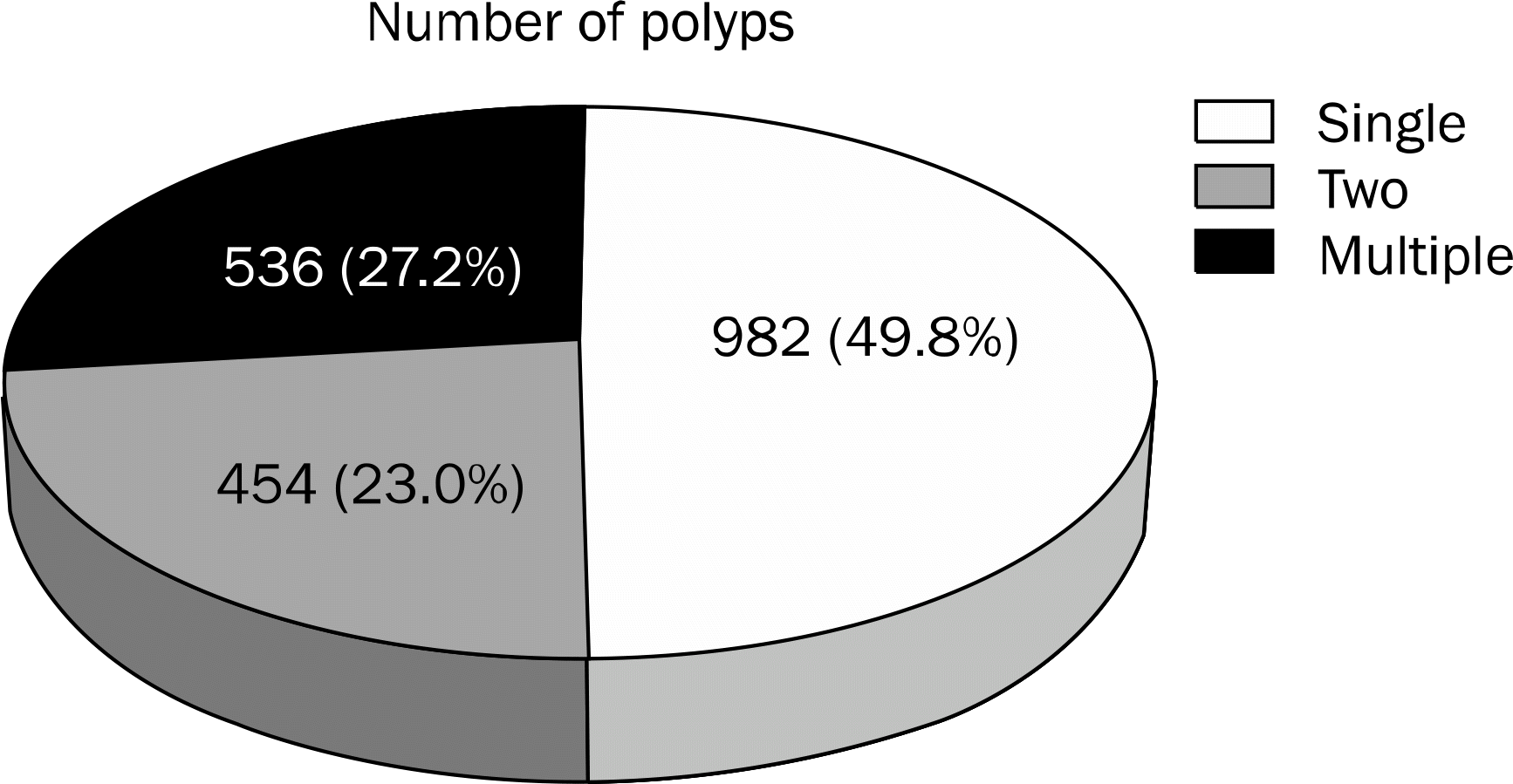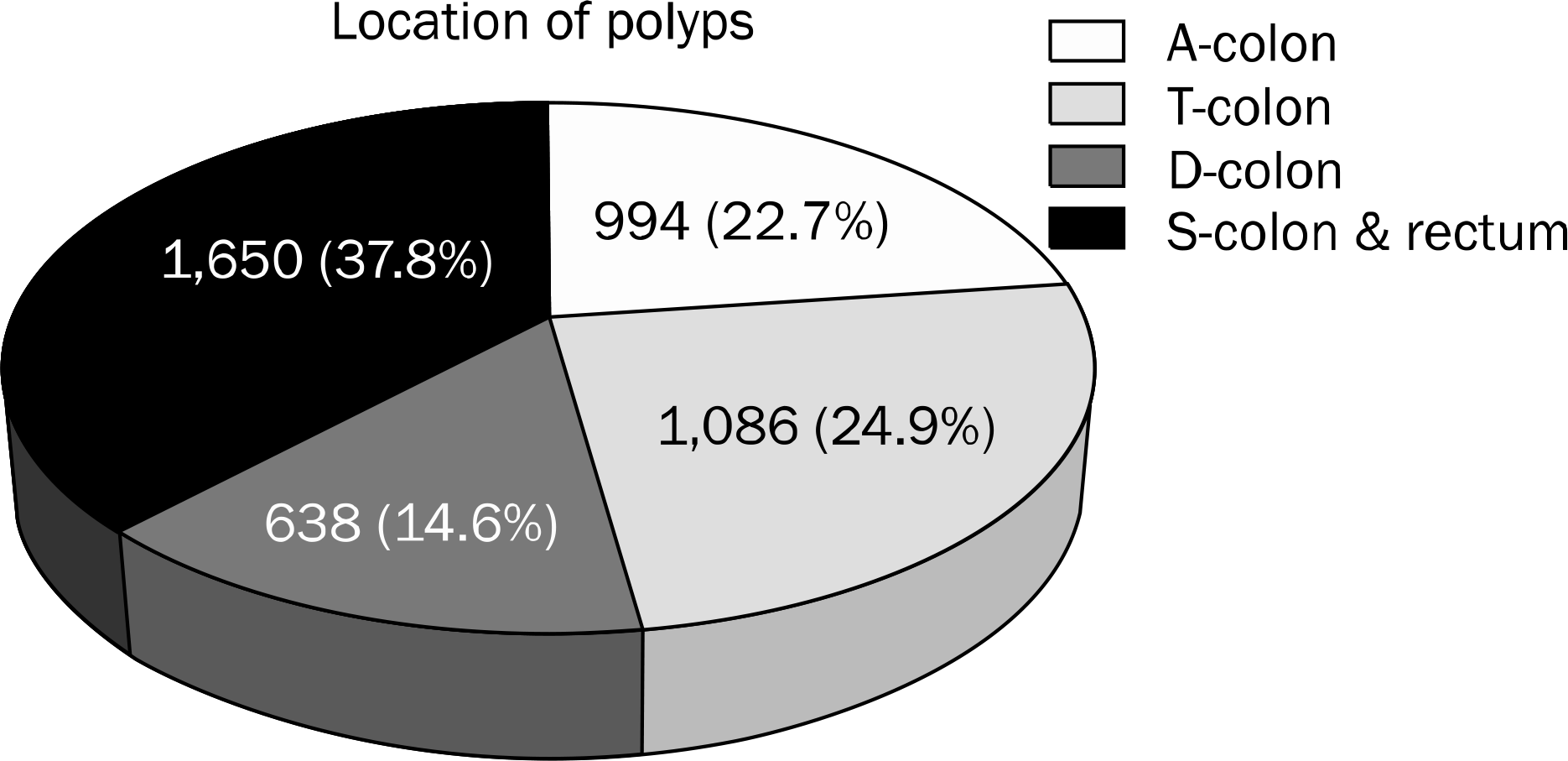Abstract
Background/Aims
Colorectal cancer is the third most common type of cancer and second leading cause of cancer death overall. Recently, there has been an emphasis on primary screening for colorectal cancer with colonoscopy. In this study, we aimed to address clinical characteristics and incidence of colonic polyps according to location.
Methods
From January 2009 to December 2010, 6,417 total colonoscopic examinations were performed at Boramae Hospital in Seoul, Korea. We reviewed these patients retrospectively. The distal colon was defined as the rectosigmoid junction.
Results
Overall, 1,972 patients (31.3%) had one of more colorectal polyps. Total of 4,445 patients were excluded from this study because of combined advanced colorectal cancer, inflammatory bowel disease, or familial adenomatous polyposis. Patients who had only proximal polyps were 633 (32.1%), 530 patients (26.9%) had both proximal and distal polyps, and 809 patients (41.0%) had polyps only in the rectosigmoid region. The prevalence of the proximal polyps in patients with rectosigmoid polyps was found to be significantly related to the male gender and elderly patients. However, the prevalence of the proximal colonic polyps was not related to the size and number of rectosigmoid polyps. In 530 patients with both rectosigmoid and proximal colonic polyps, the characteristics of proximal colonic polyps as size and number were similar to those of rectosigmoid polyps. Advanced proximal adenomas without distal polyps were found in 25 (29.4%) patients whom were associated with size and pathology.
Go to : 
References
1. Silverberg E, Lubera JA. Cancer statistics, 1989. CA Cancer J Clin. 1989; 39:3–20.
2. Ministry of Health and Welfare. Korea Central Cancer Registry. National Cancer Center. Annual report of cancer statistics in Korea in 2009. Seoul: Korea Health and Welfare Information Service;2010.
3. Youn SJ, Kim NY, Kim YT, et al. Colorectal polyp in Korea. Korean J Gastroenterol. 1991; 23:450–458.
4. Kwon JH, Lee JW, Kim BY, et al. Clinical observation of colorectal polyp. Korean J Gastroenterol. 1994; 26:465–472.
5. Levin B, Lieberman DA, McFarland B, et al. American Cancer Society Colorectal Cancer Advisory Group; US MultiSociety Task Force; American College of Radiology Colon Cancer Committee. Screening and surveillance for the early detection of colorectal cancer and adenomatous polyps, 2008: a joint guideline from the American Cancer Society, the US MultiSociety Task Force on Colorectal Cancer, and the American College of Radiology. CA Cancer J Clin. 2008; 58:130–160.

6. Ullah N, Qureshi K, Hatfield J, et al. Small early tubular adenomas and mixed colonic polyps found on screening flexible sigmoidoscopy do not predict proximal neoplasia in males. Clin Gastroenterol Hepatol. 2004; 2:246–251.

7. Kim WH, Lee SK, Chung JH, Cho YS, Yoo HM, Kang JK. Significance of rectosigmoid polyp as a predictor of proximal colonic polyp. Yonsei Med J. 2000; 41:98–106.

8. Sciallero S, Bonelli L, Aste H, et al. Do patients with rectosigmoid adenomas 5 mm or less in diameter need total colonoscopy? Gastrointest Endosc. 1999; 50:314–321.

9. Wallace MB, Kemp JA, Trnka YM, Donovan JM, Farraye FA. Is colonoscopy indicated for small adenomas found by screening flexible sigmoidoscopy? Ann Intern Med. 1998; 129:273–278.

10. Schoen RE, Corle D, Cranston L, et al. Is colonoscopy needed for the nonadvanced adenoma found on sigmoidoscopy? The Polyp Prevention Trial. Gastroenterology. 1998; 115:533–541.
11. Lee BI, Hong SP, Kim SE, et al. MultiSociety Task Force for Development of Guidelines for Colorectal Polyp Screening, Surveillance and Management. Korean guidelines for colorectal cancer screening and polyp detection. Korean J Gastroenterol. 2012; 59:65–84.

12. Bullard KM, Rothenberger DA. Colon, rectum, and anus. Brunicardi FC, Andersen DK, Billiar TR, Dunn DL, Hunter JG, Pollock RE, editors. eds.Schwartz's principles of surgery. 8th ed.New York: McGraw-Hill;2005. p. 1055–1118.
13. Winawer SJ, Zauber AG, O'Brien MJ, et al. Randomized comparison of surveillance intervals after colonoscopic removal of newly diagnosed adenomatous polyps. The National Polyp Study Workgroup. N Engl J Med. 1993; 328:901–906.
14. Newcomb PA, Storer BE, Morimoto LM, Templeton A, Potter JD. Longterm efficacy of sigmoidoscopy in the reduction of colorectal cancer incidence. J Natl Cancer Inst. 2003; 95:622–625.

15. Selby JV, Friedman GD, Quesenberry CP Jr, Weiss NS. A casecontrol study of screening sigmoidoscopy and mortality from colorectal cancer. N Engl J Med. 1992; 326:653–657.

16. Lewis JD, Ng K, Hung KE, et al. Detection of proximal adenomatous polyps with screening sigmoidoscopy: a systematic review and metaanalysis of screening colonoscopy. Arch Intern Med. 2003; 163:413–420.
17. Vatn MH, Stalsberg H. The prevalence of polyps of the large intestine in Oslo: an autopsy study. Cancer. 1982; 49:819–825.

18. Lieberman DA, Weiss DG, Bond JH, Ahnen DJ, Garewal H, Chejfec G. Use of colonoscopy to screen asymptomatic adults for colorectal cancer. Veterans Affairs Cooperative Study Group 380. N Engl J Med. 2000; 343:162–168.
19. McCashland TM, Brand R, Lyden E, de Garmo P. CORI Research Project. Gender differences in colorectal polyps and tumors. Am J Gastroenterol. 2001; 96:882–886.

20. Kim JS, Kim WH, Kim JS, et al. The significance of synchronous colorectal polyps in colon cancer proximal to the splenic flexure. Korean J Gastrointest Endosc. 2000; 20:177–182.
21. Na HG, Choi CH, Lee SK, et al. Risk of adenomatous polyps in the proximal colon according to age and gender. Korean J Gastrointest Endosc. 2005; 30:66–74.
22. Keum B, Jeen YT, Choi JH, et al. Clinical value of distal colon polyps for prediction of advanced proximal neoplasia: The KASiD prospective multicenter study. Intest Res. 2005; 3:121–126.
Go to : 
 | Fig. 1.Number of polyps. Total of 982 patients (49.8%) had a single polyp, 454 patients (23.0%) patients had two polyps and 536 (27.2%) patients had more than two polyps. |
 | Fig. 2.Location of polyps. Total of 994 polyps (22.7%) were found in the cecum and ascending colon, 1,086 polyps (24.9%) in the transverse colon, 638 polyps (14.6%) in the descending colon, and 1,650 polyps (37.8%) in the rectosigmoid colon. A-colon, ascending colon; T-colon, transverse. |
Table 1.
Baseline Characteristics of Patients with Colorectal Polyps
Table 2.
Proximal Colonic Polyps in Relation to the Characteristics of Patients
Table 3.
Distal Colonic Polyps in Relation to the Characteristics of Patients
Table 4.
Proximal and Distal Colonic Polyps in Relation to the Characteristics of Patients
Table 5.
Distal Findings in Advanced Proximal Polyps




 PDF
PDF ePub
ePub Citation
Citation Print
Print


 XML Download
XML Download